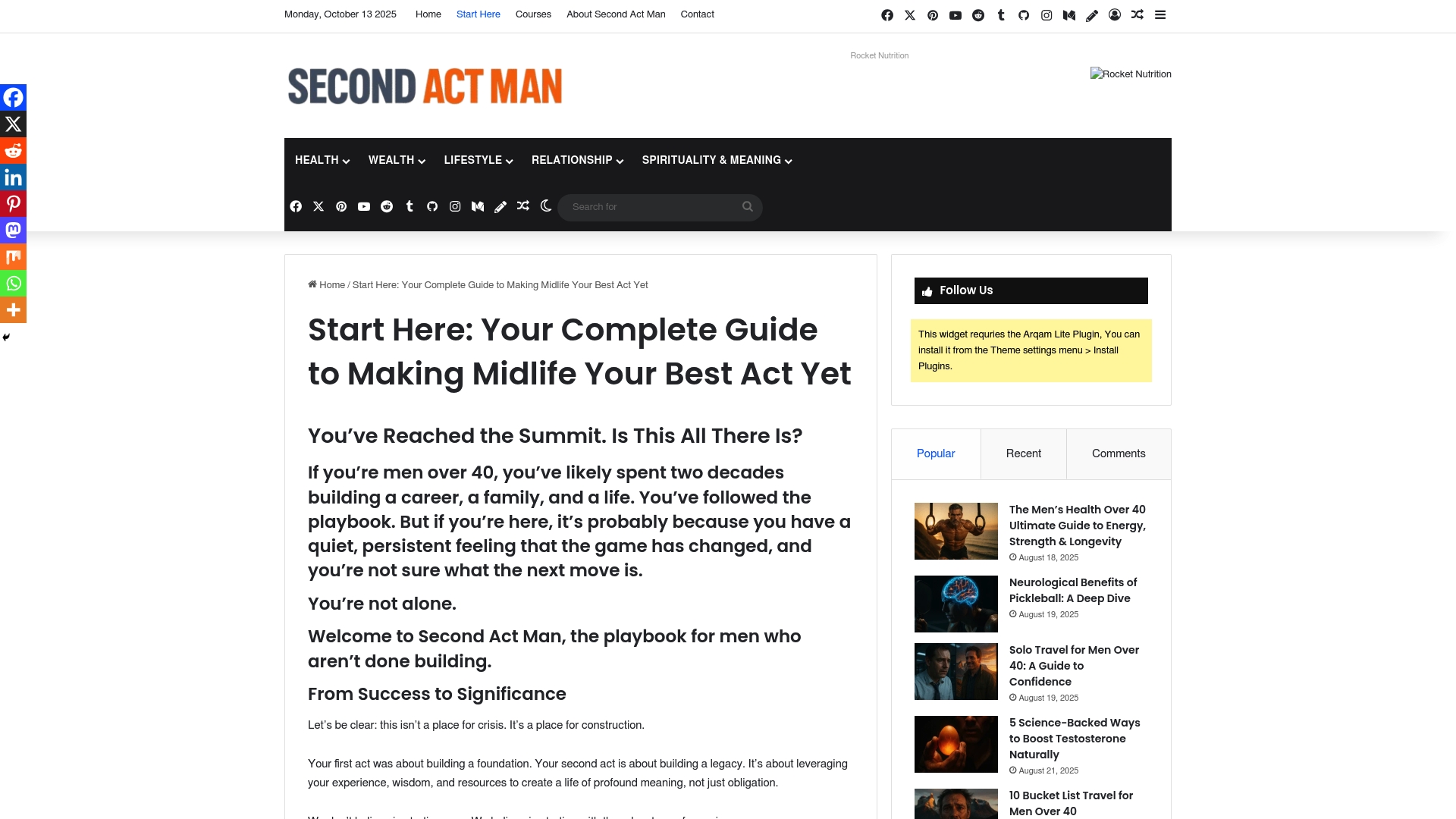Proven Weight Loss Strategy for Men Over 40 the Simple Fix

More than 70 percent of men struggle with a weight loss strategy for men over 40, yet successful long-term results remain rare. Metabolism, hormones, and lifestyle patterns all shift as you age, making old weight loss advice less effective. Understanding how these changes impact your body means you can finally create a plan that works. This guide gets straight to the practical steps men need for real, sustainable weight loss after 40.
Quick Summary: Weight Loss Strategy for Men Over 40
| Key Point | Explanation |
|---|---|
| 1. Assess your health and lifestyle | Evaluate key health markers to create a personalized weight loss plan tailored to your unique needs and challenges. |
| 2. Set realistic weight loss goals | Aim for a gradual weight loss of 1-2 pounds per week and divide your journey into three manageable phases for sustained success. |
| 3. Customize your nutrition plan | Focus on whole foods and create a nutrition strategy that fuels weight loss while ensuring overall health is maintained. |
| 4. Develop a sustainable exercise routine | Implement a balanced workout program that incorporates strength training, cardio, and flexibility to support weight loss and avoid injury. |
| 5. Track progress and adjust strategies | Regularly monitor various metrics beyond just weight, and be prepared to adapt your approach based on your progress and challenges. |
Table of Contents
- Step 1: Assess Your Current Health And Lifestyle
- Step 2: Set Realistic Weight Loss Goals
- Step 3: Customize Your Nutrition Plan
- Step 4: Develop A Sustainable Exercise Routine
- Step 5: Track Progress And Adjust Strategies
Step 1: Assess your current health and lifestyle
Understanding your current health status is the foundation of any successful weight loss journey after 40. This critical first step will help you create a personalized roadmap that recognizes your unique body and lifestyle challenges.
Start by conducting a comprehensive self assessment across multiple dimensions. According to research published in JAMA Network Open, men in midlife can significantly reduce chronic disease risks by proactively evaluating their health markers. Your assessment should cover four key areas:
![]()
Here’s a summary of the key components to assess in your initial health and lifestyle evaluation:
| Assessment Area | What to Measure | Why It Matters |
|---|---|---|
| Physical Measurements | Weight BMI Waist circumference | Establish starting point Track progress |
| Medical History | Current conditions Medication use | Identify risk factors Personalize planning |
| Lifestyle Habits | Sleep patterns Daily routines Stress levels | Reveal behavior patterns Address obstacles |
| Nutrition & Exercise | Dietary patterns Activity level | Inform caloric needs Guide adjustments |
- Physical measurements (weight, body composition, waist circumference)
- Medical history and current health conditions
- Current lifestyle habits and daily routines
- Nutritional and exercise patterns
Measure your baseline metrics objectively. Pull out a measuring tape and record your current weight, waist circumference, and body mass index (BMI). These numbers provide concrete starting points for tracking future progress.
Next, schedule a comprehensive physical examination with your healthcare provider. This professional assessment will help you understand:
- Current metabolic health
- Potential underlying conditions affecting weight
- Specific health risks associated with your current lifestyle
Pro Tip: Request a full metabolic panel and hormone level test. Men over 40 often experience hormonal shifts that can impact weight management.
A prospective cohort study of men aged 40-75 revealed that small lifestyle modifications like reducing TV time and increasing vigorous physical activity can lead to modest weight loss. Use this insight as motivation to track your current daily habits.
Finally, create a detailed lifestyle journal for one week. Document your:
- Sleep patterns
- Stress levels
- Daily food intake
- Physical activity
This baseline documentation will become your strategic planning tool for the weight loss journey ahead.
 Learn more in our guide on the midlife man’s health blueprint.
Learn more in our guide on the midlife man’s health blueprint.
Step 2: Set realistic weight loss goals
Establishing achievable weight loss targets is crucial for maintaining motivation and ensuring long term success. Your goals need to be strategic sustainable and specifically tailored to your midlife body and lifestyle.
Clinical guidelines offer clear scientific guidance for effective weight loss planning. According to research published by the National Institutes of Health, the most successful approach involves targeting approximately 10 percent of your baseline body weight with a steady sustainable rate of 1 to 2 pounds per week.
Break your overall weight loss journey into three distinct phases:
- Initial phase: First 3 months (most critical)
- Intermediate phase: 4 to 6 months
- Maintenance phase: Beyond 6 months
In the initial phase focus on establishing consistent habits rather than dramatic transformations. Your primary objective should be creating a daily calorie deficit of 500 to 1000 calories through a combination of dietary adjustments and increased physical activity.
Pro Tip: Calculate your baseline metabolic rate and create a modest calorie reduction strategy that supports steady weight loss without triggering metabolic resistance.
Consider setting multiple goal types to keep yourself motivated:
- Performance goals (exercise frequency, workout intensity)
- Measurement goals (inches lost, waist circumference)
- Weight goals (total pounds to lose)
Remember that progress is not linear. Some weeks you might lose more weight while other weeks might show slower results. The key is consistency and commitment to your overall strategy.
Track your progress using multiple metrics beyond just weight. Take progress photos measure body composition and monitor how your clothes fit. These additional tracking methods will help maintain motivation during plateaus.
Explore our midlife reboot guide for more comprehensive strategies to help you stay focused and motivated throughout your weight loss journey.
Step 3: Customize your nutrition plan
Creating a personalized nutrition strategy is about understanding your body and designing an eating approach that fuels your weight loss goals while supporting overall health. At this stage you will transform generic dietary advice into a targeted plan that works specifically for you.
The key is finding a sustainable nutritional approach that doesn’t feel like a restrictive diet. According to evidence based research highlighting the DASH diet framework experts recommend focusing on whole foods that naturally support metabolic health for men over 40.
Start by building a foundational nutrition template that includes:
- Lean proteins (chicken fish turkey eggs)
- Abundant vegetables and low glycemic fruits
- Whole grains with complex carbohydrates
- Healthy fats from sources like avocados nuts olive oil
- Limited processed foods and refined sugars
Understand your specific caloric needs by calculating your basal metabolic rate and daily energy expenditure. This personalized approach ensures you are eating enough to support muscle maintenance while creating a modest calorie deficit for weight loss.
Pro Tip: Meal prep is your secret weapon. Prepare protein rich meals in advance to prevent impulse eating and maintain nutritional consistency.
Incorporate strategic nutritional principles:
- Eat protein with every meal to support muscle retention
- Consume vegetables as primary carbohydrate sources
- Time larger carbohydrate meals around physical activity
- Stay hydrated with water as primary beverage
Consider working with a registered dietitian who understands midlife male metabolism. They can help you design a nutrition plan that accounts for changing hormonal landscapes and potential metabolic slowdown.
Remember that nutrition is not about perfection but consistency. Small sustainable changes compound into significant results over time.
Explore our midlife health blueprint for deeper nutritional insights
Step 4: Develop a sustainable exercise routine
Building an exercise routine after 40 requires a strategic approach that balances effectiveness with your changing physiology. This step is about creating a workout plan that supports your weight loss goals while protecting your joints and maintaining muscle mass.
Research focusing on men aged 40 to 75 reveals a critical insight: increasing vigorous physical activity plays a significant role in sustainable weight management. The key is designing a routine that challenges your body without risking injury.
Structure your exercise plan around four fundamental components:
- Strength training (2 3 sessions per week)
- Cardiovascular exercise
- Flexibility and mobility work
- Active recovery days
Strength training becomes increasingly important as metabolism naturally slows. Focus on compound movements that engage multiple muscle groups such as:
- Squats
- Deadlifts
- Pushups
- Rowing exercises
- Bodyweight resistance training
Pro Tip: Start with lighter weights and perfect your form. Gradually increase intensity to prevent injuries and build sustainable muscle strength.
Integrate high intensity interval training (HIIT) for efficient calorie burning. These short bursts of intense activity followed by recovery periods can dramatically improve metabolic function and support weight loss efforts.
Consider your individual fitness level and any existing health conditions. Begin with low impact modifications and progressively increase workout complexity. Listen to your body and allow adequate recovery time between intense sessions.
Make exercise enjoyable by mixing different activities. Try group fitness classes martial arts cycling or functional training programs that keep you engaged and motivated.
Remember that consistency trumps intensity. A moderate workout performed regularly will yield better results than sporadic intense sessions.
Learn more about midlife fitness strategies in our comprehensive reboot guide
Step 5: Track progress and adjust strategies
Successful weight loss is not a linear journey but a dynamic process of continuous monitoring and strategic adaptation. This step transforms your weight loss approach from a rigid plan to an intelligent responsive system that evolves with your body and progress.
Research from the National Weight Control Registry reveals that consistent self-monitoring is a hallmark of long term weight loss success. Modern technology now makes tracking more sophisticated and accessible than ever before.
Implement a multi dimensional tracking system that goes beyond simple weight measurements:
- Body composition percentages
- Circumference measurements
- Fitness performance metrics
- Energy levels and mood tracking
- Sleep quality indicators
Leverage technology to your advantage. Wearable devices and smartphone applications can provide predictive insights into your weight loss trajectory. According to advanced research using AI and wearable technologies, personalized monitoring significantly improves the likelihood of achieving meaningful weight loss.
Pro Tip: Take weekly progress photos from consistent angles. Visual documentation often reveals changes that scale measurements might miss.
Establish a regular check in schedule:
- Weekly weight and measurement check
- Bi weekly nutritional log review
- Monthly comprehensive progress assessment
- Quarterly fitness performance evaluation
Learn to interpret data intelligently. Plateaus are normal and do not indicate failure. They represent opportunities to recalibrate your nutrition and exercise strategies.
Be prepared to make informed adjustments. If your current approach stops yielding results consider:
- Modifying calorie intake
- Changing exercise intensity
- Introducing new workout variations
- Consulting with a fitness professional
Remember that sustainable weight loss is about consistent intelligent adaptation not perfection.
Explore our midlife reboot guide for advanced tracking strategies
Ready to Take Control of Your Weight After 40?
Struggling to stick to a proven weight loss strategy after 40 can feel overwhelming. If you have assessed your health, set realistic goals, and still face challenges like stubborn belly fat or inconsistent motivation, you are not alone. Many midlife men want to lose weight, build muscle, and keep up energy, but real-world results often fall short without the right plan and community support. Let this be your turning point. Review actionable tips and step-by-step advice in our How to Lose Belly Fat & Manage Weight After 40 section to get the clarity and structure you need.

Why wait to create the best version of yourself? The fastest way to success is to surround yourself with proven strategies and a network of men on the same path. Take the next step by exploring all our expert resources and practical solutions tailored to you at SecondActMan Start Here. Commit to change today, and let purpose and progress define your next chapter.
Frequently Asked Questions
What are the first steps in a proven weight loss strategy after 40 for men?
Begin by assessing your current health and lifestyle. Measure your weight, waist circumference, and BMI, and document your daily habits for a week.
How can I set realistic weight loss goals after 40?
Set achievable targets by focusing on losing about 1 to 2 pounds per week, which equals approximately 10% of your baseline body weight. Break your journey into phases, starting with consistent habits in the initial three months.
What should I include in my nutrition plan for weight loss after 40?
Create a personalized nutrition plan that includes lean proteins, abundant vegetables, whole grains, and healthy fats. Prioritize whole foods while ensuring you maintain a calorie deficit to support weight loss.
How can I develop an effective exercise routine after 40?
Structure your routine around strength training, cardiovascular workouts, flexibility, and active recovery. Aim for at least 2 to 3 strength training sessions each week, incorporating compound movements.
How do I track my weight loss progress effectively?
Implement a multi-dimensional tracking system that includes body composition, measurements, and fitness performance metrics. Review your progress weekly and adjust strategies based on your outcomes to stay on track.
What are some common challenges men face in weight loss after 40?
Many men experience hormonal shifts and metabolic slowdowns, which can impact weight management. Recognize these changes and adapt your nutrition and exercise routines accordingly to mitigate their effects.







